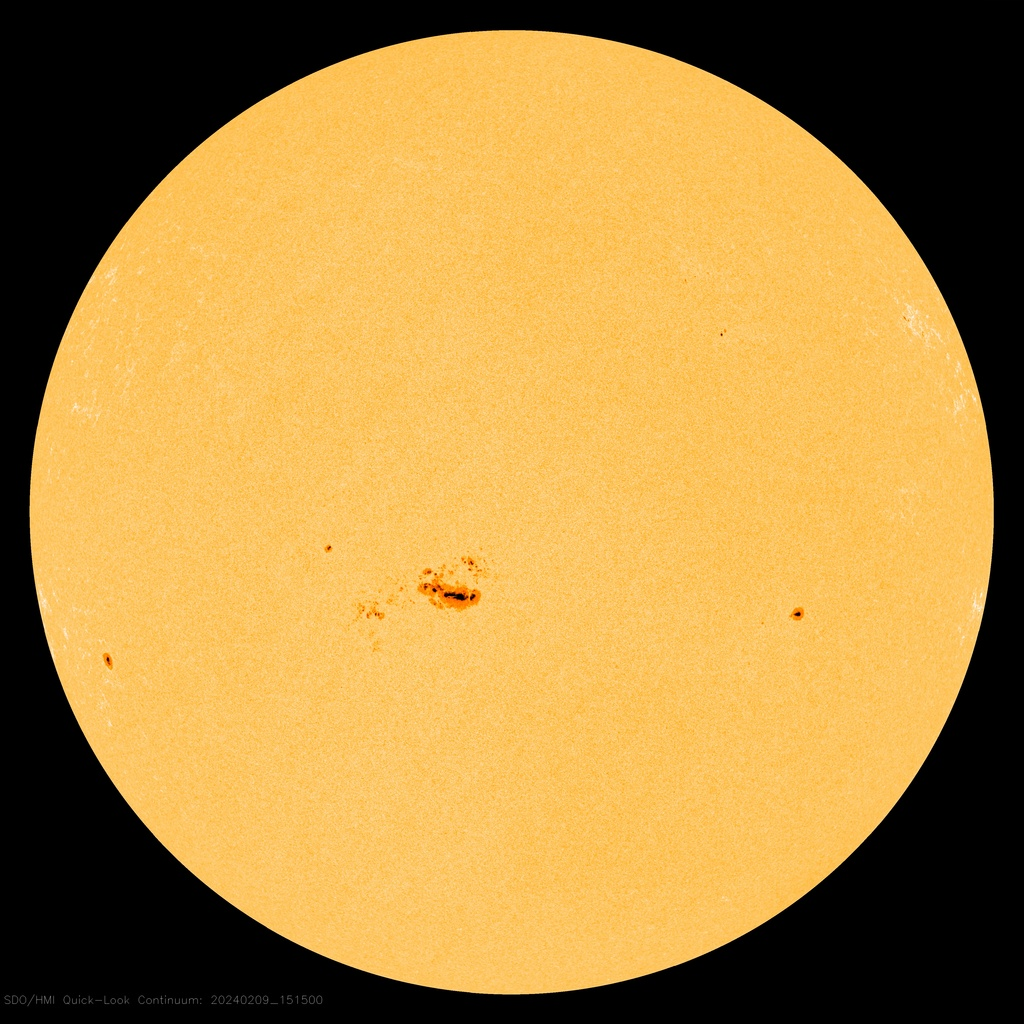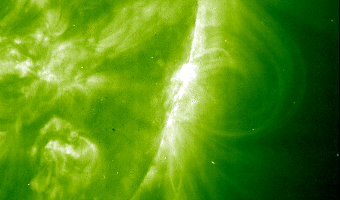If you’re a North American who has acquired eclipse glasses early for the April 8 event, or just someone who has old ones lying around, now might be a good time to get them out. The giant grouping of sunspots collectively known as AR3576 is approaching the middle of the side of the Sun facing us. It’s so large that Perseverance was able to see it from Mars, and it has grown bigger since, so if you’ve got safe material for looking at the Sun, you should see it without magnification. That could be particularly memorable if AR3576 also spits out X-class flares, whose impact goes into the history books.
Big sunspots do not always produce large solar flares, but there is a connection. Consequently, it’s quite plausible we will soon witness X-flares associated with AR3576. If we don’t, we can still expect to encounter them before this solar cycle is over – after all we had one in December. So what are they?
What are solar flares?
As we know, the Sun is a constant source of light, which is a form of electromagnetic radiation, and it also radiates at other wavelengths. Every now and then, however, a small (or sometimes not so small) part of the Sun releases more electromagnetic radiation than usual. The extra brightness is not so great that we notice the Sun as a whole getting brighter, but if we have telescopes trained on the area, we can see the brightening patch.
Flares are a consequence of irregularities in the Sun’s magnetic field. Initially, the field will block some of the heat rising from the center of the Sun, causing a sunspot. However, when the field gets tangled or reorganizes, the energy released can accelerate charged particles through the Sun’s atmosphere, producing a swift extra burst of energy.

It’s not hard to spot AR3576 on this recent image of the Sun – not one sunspot, but an immense cluster.
Image credit: SDO/NASA
The larger the sunspot, the greater the flare potential, but the relationship between them is far from perfect. Both rise and fall with the 11-year solar cycle, the peak of which we have either just seen, or will see soon.
A big spot does not guarantee big flares, but it certainly raises the chances.
How are solar flares categorized?
Flares are categorized into five classes based on the peak flux in watts per square meter (W/m2), counting only the energy released at between 1 and 8 Angstroms (known as soft X-rays). For decades, successive Geostationary Operational Environmental Satellites (GOES) have had the job of measuring the energy released by flares so they can be classified.
The smallest flares, A-class, peak at less than 10-7 W/m2, which is almost too small to notice at our distance. B and C classes (respectively 10-7-10-6 and 10-6–10-5 W/m2) are of interest to solar astronomers, but have little effect on most people.
M-class flares (10-5–10-4 W/m2) can be associated with aurora and sometimes radio blackouts and other inconvenient phenomena.
The largest flares, those with more than 10-4 W/m2, are called X-class. There is no theoretical limit on how large the X-class can be. Within the other classes, flares are subdivided 1-10, but the largest flare encountered by GOES was so powerful it saturated its detectors, leaving astronomers to estimate its size at X40-X45.
An X-flare’s number indicates how many times as energetic it is as an X1 flare, so an X9 is nine times as powerful as an X1, around 9 x 10-4 W/m2.

The largest solar flare ever measured saturated instruments capable of measuring up to X28, leaving us to estimate how much higher it was.
Image credit: SOHO/EIT (ESA & NASA)
Are solar flares a threat?
Definitely, but also not directly.
The first thing to note is that the problem is seldom the flares themselves. The threat arises from coronal mass ejections (CMEs) that fling charged particles into space. When large CMEs encounter the Earth’s magnetosphere they can cause geomagnetic storms, producing everything from pretty lights near the poles to generating induced currents that can disrupt power grids, plunging regions into darkness.
Most flares don’t produce CMEs, but the larger a flare is, the more powerful a CME it can trigger.
As you probably noticed, the world suffered no serious consequences from recent X-flares, but the fact that not every X-flare is damaging doesn’t mean none are.
Unsurprisingly, we have more to fear from an X50 flare than an X5. Direction, however, is at least as important as size. Half of X-flares are on the far side of the Sun and we’re only aware of them if a spacecraft happens to be suitably positioned to notice. Even flares that are on the side we can see won’t affect us much if pointed away from the Earth.
The flares we need to worry about are those that are both powerful and score direct hits on the Earth’s magnetosphere.
The standard against which flares are measured is the Carrington Event. Although the damage was limited to a few shocked telegraph operators and some fires, it occurred in a world where telegraph lines were the only long stretches of wire in which induced currents could grow to dangerous levels. Today, a similar event could knock out satellites, cause trains to crash, or blow electrical transformers, rendering our communications networks and sources of energy useless, potentially taking weeks or months to restore.
Moreover, the Carrington Event may be far from the limit. Tree rings reveal evidence of so-called Miyake events which, as far as we can tell, are flares that make the Carrington Event look small. We don’t know what a Miyake Event would do to a technological civilization like our own, but it’s unlikely we’d enjoy it.
Source Link: What Are X-Flares And Should We Be Worried About Them?